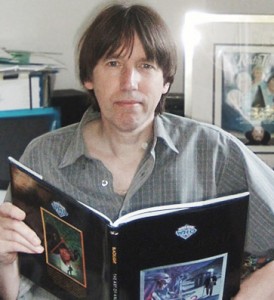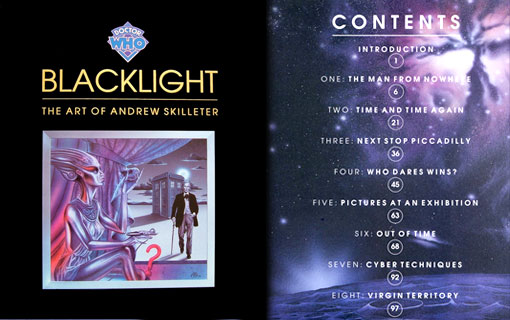 Blacklight : The Doctor Who Art of Andrew Skilleter, a large format, all colour hardback written by the artist and published by Virgin in 1995, showcased his canon of professional Doctor Who work and its breadth, ambition and variety.
Blacklight : The Doctor Who Art of Andrew Skilleter, a large format, all colour hardback written by the artist and published by Virgin in 1995, showcased his canon of professional Doctor Who work and its breadth, ambition and variety.
The concept for Blacklight was born out of the ashes of Who Dares. Virgin Books had taken over W H Allen becoming the Doctor Who publishers. In late 1989 I formally pitched the idea of an art book to Peter Darvill-Evans who was the then Doctor Who editor.
Here is the greater part of my letter to Peter Darvill-Evans of 8th November 1989 :
THE ART OF DOCTOR WHO/ANDREW SKILLETER
(Working Title) This has been in my mind for some time (& in the mind of others) but have not had the time to focus on it (particularly in the light of the possibility of ‘Monsters’). However, interest in such a book has come from three other publishers and with this being my tenth year with WHO and it representing large resource, I realise I must focus on it.’
Obviously I am looking for the best possible package and the best guarantee of sales. Whilst being a WHO book I would be losing to it appealing to the fantasy art market in general, using some of the roughs, preliminary drawings and concept sketches and to discuss technique, approach. I would possibly develop a few ideas with some new pieces (eg the ArcHivists from the Cyberbook etc.). It would cover my years with WHO, special involvements such as the BBC USA Traveling Exhibition (I designed the exterior), the Who Dares story, The Target years & so on.
I would propose writing it and designing and could provide CRC. It would have to be an all four-colour publication on art paper, no smaller than the Cyberbook and a max. Of 144 pages. I think the page count would depend on the angle we go for – there is the deluxe hardback route with heavy art paper and fewer pages (96 or so) or the paper ‘Paper Tiger’ format.
‘ …I have 100 colour WHO pieces to date plus 16 line/mono spreading over book covers, books,, posters, calendars and special projects. These include 49 pieces produced for Target covers. They may indeed be a certain cachet in ‘the complete Dr Who artwork of…’ but my main interest would be profiling the largest and most deserving or interesting of the pieces – and presenting them in a fresh way at a new size…
I resubmitted a detailed proposal in January 1991, with a working title of Tempus and later that year it was contracted. It was to be six years before Blacklight was finally published. The full explanation such a delay are lost in the mists of time but in a nutshell it was a mixture of work commitments, my return to Doctor Who work – covers and The Monsters book for Virgin, the VHS covers for the BBC and a house move at the end of 1992. I was struggling and quite frankly I was fortunate not to have the lost the opportunity altogether. Maybe the fact that the contract had been signed and a decent advance paid, helped keep me in the frame. In my letter to Peter of March 1994 there was an air of desperation and frustration but I was able to tell him that it was written and the material was ready. As it turned out the delay had it’s advantages. It was now over fifteen years I had been associated professionally with Doctor Who. By the time of final preparation I had under my belt The New Adventures covers, The Monsters book and around twenty four Doctor Who covers for BBC video, a selection of which greatly enriched the book.
Blacklight was overtaken by the publication of the excellent Timeframe by David Howe with which I fully co-operated and it features pieces of my work not seen in Blacklight. In fact, it influenced what would not appear in Blacklight.
 Peter gave me every freedom so the book is a very personal statement; I set out the structure of the book, wrote around 12,000 words, devised the chapters and titles and selected the images. The minimum of alterations required by the publishers. I had the pleasure of meeting Peter after many years at a shoot for a BBC documentary on Terrance Dicks and was able to tell him again of the debt I owed him for recommending publication and then seeing the concept through to publication. Blacklight brought together all the disparate strands of my Who work into a single volume and made me aware, let alone any reader, just how much I’d achieved in this area. I wrote the text on an electric typewriter – this was shortly before we acquired our first computer – and in the end it was a physical cut and paste job! It was not the easiest time in my life and I decided to take an aggressively, positive stance writing the account of my Doctor Who years, celebrating what I had achieved. I needed to. Not that I held back from some reservations at times within the text.Without Blacklight there would be a big black hole in my career and life. As a creative achievement, and with the distance of years, I’m just so proud of it. I now own all the rights to the title.
Peter gave me every freedom so the book is a very personal statement; I set out the structure of the book, wrote around 12,000 words, devised the chapters and titles and selected the images. The minimum of alterations required by the publishers. I had the pleasure of meeting Peter after many years at a shoot for a BBC documentary on Terrance Dicks and was able to tell him again of the debt I owed him for recommending publication and then seeing the concept through to publication. Blacklight brought together all the disparate strands of my Who work into a single volume and made me aware, let alone any reader, just how much I’d achieved in this area. I wrote the text on an electric typewriter – this was shortly before we acquired our first computer – and in the end it was a physical cut and paste job! It was not the easiest time in my life and I decided to take an aggressively, positive stance writing the account of my Doctor Who years, celebrating what I had achieved. I needed to. Not that I held back from some reservations at times within the text.Without Blacklight there would be a big black hole in my career and life. As a creative achievement, and with the distance of years, I’m just so proud of it. I now own all the rights to the title.
Mark Stammers was responsible for the design and came up with the title. He and I fought hard for the use of the Doctor Who diamond logo which I consider a design classic. I could not have wished for a better designer and quite simply he did a brilliant job and made Blacklight stand out amongst other art books. Thank you Mark.
Regrets? I have a few. These were, unbelievably, pre-email, internet and website days which limited what I could do personally and both myself and the publishers failed to promote the book sufficiently. I did do a few signings, the main one linked with another Who title and Forbidden Planet in London. In early February 1996, John Nathan-Turner wrote to me. I thought it was a generous and warm gesture and reproduce the letter here.
This feature is dedicated to the memory of John Nathan-Turner
A review from Amazon.com
‘Skilleter’s art is a part of Doctor Who’s success! March 25, 2002
Reviewer: © Daniel J. Hamlow (Farmington, NM USA)
As someone who collected Dr. Who videos and novelizations, including the New Adventures, I’m familiar with Andrew Skilleter’s work. An entire book devoted to his Who stuff (well, most of it, anyway)? Wow!
I never got any of the early calendars, of which material from the hit 1986 calendar is sampled. No, my first step into Who came in 1988. But the calendar art included is a treasure. Sil, with his marsh minnows beside him is just adorable. And check out the exploding Dalek from the 1986 calendar. He is strong in rendering all Who-related subjects, nothing weak in ANY of them. I must say that of the Doctors, he does Peter Davison and Sylvester McCoy the best.
Speaking of 1988, the shot of Tom Baker for the calendar that year includes a space-station shaped like a birthday cake for the 25th anniversary. Well, that kind of fulfills Baker’s suggestion of pulling out a cake for The Stones Of Blood, the 100th story in the series.
Of the Profile Print posters I bought, I hung the Cybermen and Sontaran ones in my dorm room at NMSU.
His portraits of each of the then-six Doctors in the Kevin Judd Collection are masterpieces. Love that celery to the right of Peter Davison. Gouache is his preferred medium and perhaps it’s because it’s the same medium used by Olivia de Berardinis that I took to the art on the videos and books.
Now here’s the trick. I’d bought the two books he’d done before I bought Blacklight, and that was The Cybermen with David Banks and The Monsters with Adrian Rigelsford. That cover of the Cybermen book is simply awesome! It didn’t sink in until I bought Blacklight that that guy who drew the art in those books was Andrew Skilleter. Sure, his name was written on the books’ spines but I was too absorbed in the text to find out. Now though, I have a special appreciation for the artwork.
In closing, I’ve no beef against the designs of the video releases since the E-Space Trilogy, but to me, part of owning a Doctor Who video collection is Andrew Skilleter’s rich and imaginative cover art. Check out Blacklight and see what you’re missing.




